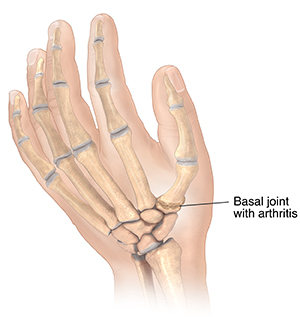Arthritis is a disease that causes inflammation, pain, and stiffness in the joints. The disease slowly gets worse. It often affects the joint at the base of the thumb (basal joint). Basal joint arthritis is most common in women over 40, but anyone can get it. Often it happens in both thumbs.
Causes
Basal joint arthritis occurs due to wear and tear on the joint. It is often called osteoarthritis or degenerative arthritis. It's more likely to occur and happen at a younger age if you have broken or injured your thumb. Repeatedly gripping, twisting, or turning objects with the thumb and fingers may make the arthritis worse.
Inside your thumb
The basal joint is formed by 1 of the wrist bones (trapezium) and the first of the 3 bones in the thumb (first metacarpal). This joint allows the thumb to move and to pinch with the fingers. When arthritis occurs in the basal joint, it slowly destroys the joint.
Arthritis irritates or destroys the joint
The ends of the bones are covered with cartilage. This covering acts like a cushion. This lets the bones move smoothly. Arthritis wears away or destroys the cartilage. Then the bones rub against each other when you move your thumb. This causes the joint to become stiff, inflamed, and painful. This makes pinching and grasping with the thumb and fingers painful. With time, the bone in the thumb may collapse. Then you can no longer straighten your thumb.
Symptoms
The most common symptom is pain in the lower part of the thumb. You may feel pain when you lift something with the thumb and fingers, unscrew a jar lid, grip an object, or turn a door handle or a key. You may find yourself dropping things. Weather may also make the thumb hurt. The joint may swell. With time the thumb may become stiff or deformed.


